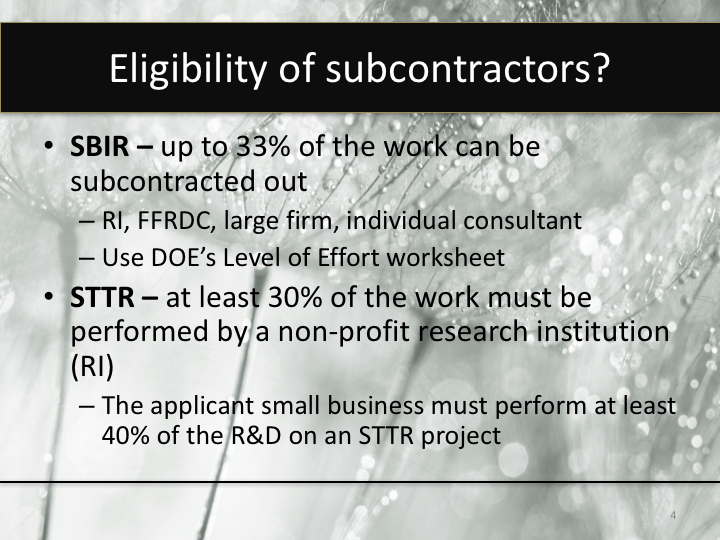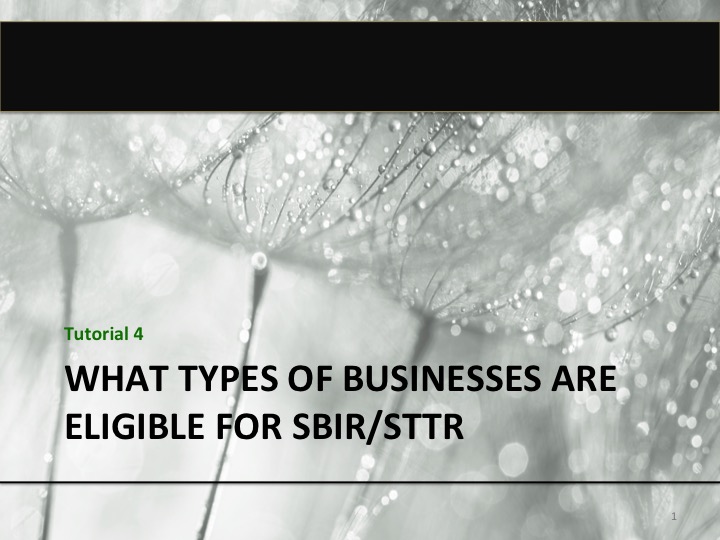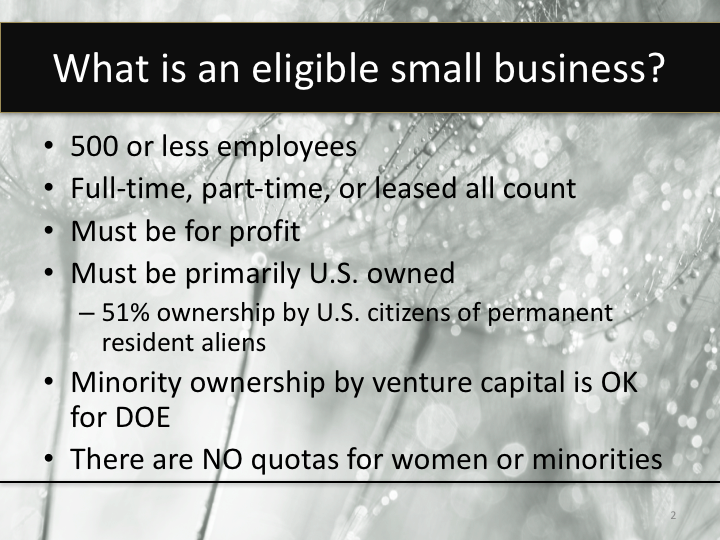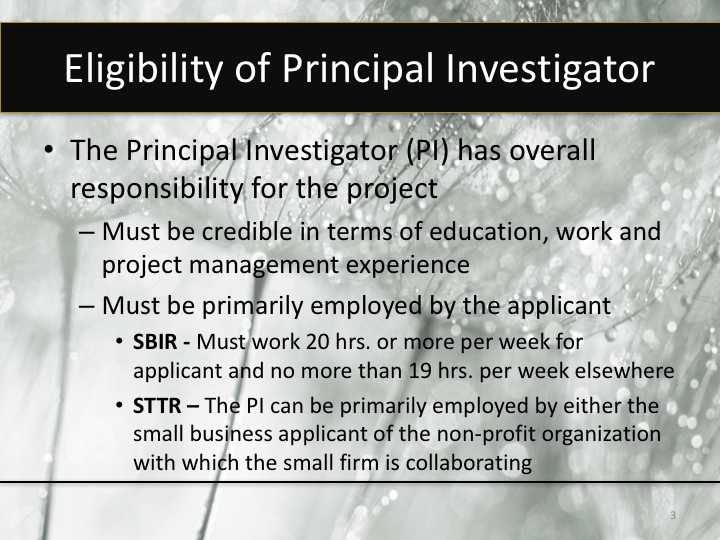Tutorial 4:
What types of businesses are eligible for SBIR/STTR?
To participate in the SBIR or STTR program, an applicant must meet a number of eligibility requirements. These requirements pertain to the applicant itself, its principal investigator, and its subcontractors. Let’s discuss each of these starting with company eligibility.
Only certain types and sizes of small business may apply for and receive SBIR or STTR awards. Some mistakenly believe that universities can submit STTR proposals, when in fact those proposals must be submitted by small businesses that are collaborating with universities or other non-profit research organizations on the STTR project. Remember, it is the Small Business Innovation Research and Small Business Technology Transfer programs, so a small business must be the applicant as well as the responsible business and technical lead on the proposal.
So what is a small business? The SBIR/STTR definition is fairly simple. It is a firm with 500 or fewer employees. It does not matter if they are full- or part-time employees, or even leased employees—they count toward the 500 worker limit.
The small business must be for profit, and therefore non-profit entities (e.g., those with a 501(c)(3) designation by the IRS) are not eligible—although once again they could be a subcontractor or consultant to the small, for profit applicant.
The small business needs to be primarily U.S. owned. This is defined as having at least 51% of its ownership by U.S. citizens and/or permanent resident aliens. This requirement also could be met if the applicant is at least 51% owned by another small business (i.e., 500 or fewer employees), as long as that parent business is at least 51% owned by U.S. citizens or permanent resident aliens. It is possible for the applicant to be owned partially by U.S. citizens/permanent resident aliens and partially by another small business, as long as collectively it can be shown that 51+% of the ownership of the applicant is by U.S. citizens or permanent resident aliens.
When small businesses are venture-backed, additional considerations come into play. Small businesses that are majority-owned by venture capital operating companies, hedge funds, or private equity firms are not eligible for funding under the DOE FOA.
The SBIR and STTR programs encourage participation by small businesses that are minority- and/or woman-owned. However, there are no quotas or set asides for such firms. The DOE has a Phase 0 program to assist such firms in their applications to the agency’s SBIR and STTR programs; see http://www.dawnbreaker.com/doephase0/services.php for more information.
Let’s now address the eligibility of the Principal Investigator or PI. Every DOE SBIR and STTR proposal must designate a single individual who will serve as the principal investigator (PI) on the proposed project. The PI has overall responsibility for the project, and therefore must be credible in terms of his/her educational, work and project management experience.
The PI has to meet certain eligibility requirements on a DOE SBIR/STTR proposal. For SBIR projects, the PI must be “primarily employed” by the applicant small business during the SBIR grant period. This means that he/she must work 20 or more hours per week for the applicant company, and can’t work more than 19 hours per week for any other employer, during the time that the DOE SBIR/STTR grant is active.
The rules for STTR are a little different at DOE: in an STTR project, the PI can be primarily employed by either the small business applicant or the non-profit organization with which the small firm is collaborating on the STTR project. If the STTR PI is primarily employed with the applicant company, he/she must work 20+ hours per week for that company and not more than 19 hours with another organization. If the PI is primarily employed by the non-profit collaborator on the STTR project, then the PI must work at least 20 hours per week at that institution.
PIs also must be able to dedicate a “considerable” amount of time on the DOE SBIR/STTR project. On Phase I projects, they must commit an average of at least 3 hours per week, or a minimum of 117 hours on a 9 month Phase I.
Now let’s examine Subcontractor eligibility. On a Phase I SBIR project, up to 33% of the research can be subcontracted to another entity. That entity can be anything from a non-profit research institution such as a university or Federal laboratory, to an individual consultant, or a large prime contractor. The 33% must be measured using DOE’s Level of Effort worksheet found on its website, and all of the research must be performed within the United States, unless DOE allows an exception.
On STTR projects, either Phase I or II, at least 30% of the research must be performed by a non-profit research institution or RI. The RI typically is a university (public or private) or a Federal Laboratory (provided it qualifies as a Federally Funded Research and Development Center or FFRDC). The applicant small business must perform at least 40% of the R&D on an STTR project, so the RI could do as much as 60% of the research. A single RI must provide at least 30% of the research, while either the same entity or other subcontractors and consultants could contribute additional amounts so that the total does not exceed 60%.
There are other DOE Eligibility Requirements. A small, for profit firm is not eligible to submit a Phase I SBIR or STTR proposal to DOE unless it has submitted a Letter of Intent (LOI). The LOI deadline typically precedes the full Phase I proposal submission deadline by about 6 weeks. For more information on Letter of Intent, please refer to the module on the Letter of Intent.

Small firms can have their DOE Phase I proposals considered for both the SBIR and STTR programs if they are subcontracting between 30% and 33% of the research to a non-profit research institution. This is a unique feature of the DOE that only requires you to submit one proposal to have two chances of getting your project funded.
DOE has specific limits on employment and ownership overlaps among entities participating in an SBIR or STTR project. More specifically,
- No owners or employees of the applicant company can be paid consultants on the project
- No owners or employees of the applicant company can be employees of a subcontractor on the project, except when the sub is a U.S. non-profit research institution like a university or FFRDC.
- Consultants cannot be employees of a subcontractor on the project
Be sure that you review and understand the eligibility requirements before you begin to invest time in developing your proposal to assure that your firm is eligible and that you comply with DOE’s guidelines.
Quiz: Tutorial 4: What types of businesses are eligible for SBIR/STTR?
1
Universities and federal labs can apply for STTR grants, as long as they subcontract some of the work to small businesses.
Nice Work
Try Again
2
Which of the following statements is NOT accurate?
Nice Wok
Try Again
3
Which of the following statements is correct?
Nice Work
Try Again
4
Which of the following could be a subcontractor on an SBIR project?
Nice Work
Try Again
5
A Phase I proposal to DOE can be considered for both the SBIR and STTR programs as long as it includes a non-profit research entity contributing more than 33% but less than 30% of the research.
Nice Work
Try Again


